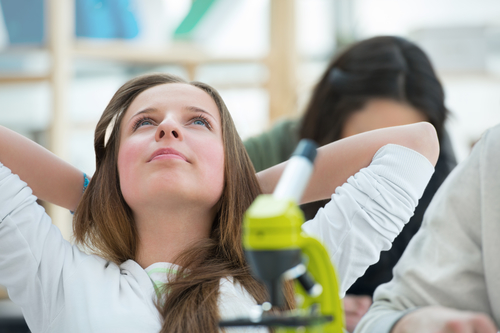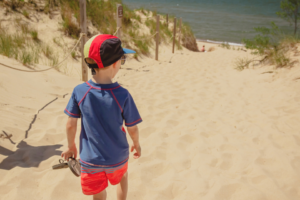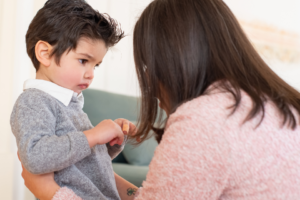
How to Incorporate Mindfulness in the Classroom

Mindfulness is the practice of slowing down and being more present in the here and now. This can benefit both young and old as well as everyone in between. The site Mindful Teachers says that, “when we practice mindfulness on a daily basis, it promotes well-being, compassionate actions, and greater performance.” Mindfulness has powerful positive potential in classrooms; for example, a Baltimore elementary school offered meditation to students with behavioral issues and reduced their suspension rate to zero. Here are a few ways that you can incorporate mindfulness into your classroom:
Breathing Mindfully
Breath is often referred to as an “anchor” in mindfulness training and can be a helpful place to focus attention when one is feeling distracted or stressed. Even very young children can be taught to feel their breaths moving in their tummies and lungs by placing their hands on their abdomens and/ or chests. If you are leading a mindful breathing exercise, you can simply instruct children to close their eyes and place their hands on their stomachs. You could ask them to take slow breaths and to feel their bellies fill up and then empty like balloons. Children might also say silently to themselves, “in”, and “out” as they breathe or count to ten and back to zero again. It’s not a bad idea to try this yourself and reap the calming rewards—when you are more mindful and present, this will be of benefit to both you and to your class. Mindful Schools shares that, “awareness of the breath is one of the foundational exercises for learning mindfulness meditation. It’s a popular starting point because the breath is something you can always access.”
Feeling Sensations Mindfully
A second point of focus that is easily accessible is the body’s sensory experiences. Children learning about the five senses can focus on each of their senses in turn. As their teacher, you are in a position to provide them with rich sensory opportunities such as colorful artworks, sensory tables with sand or ice, interesting sounds, and the tastes and smells of cooking projects. You can ask children to close their eyes when they are focusing on non-sight senses and to also describe their sensory experiences through speech, writing, or visual art. Bringing attention to and honoring students’ experiences of being in their bodies helps them to fully experience the present.
It’s worth noting here that mindfulness and the practice of sitting still and feeling into the body can sometimes bring up anxiety or difficult feelings for both children and adults. A common response to this experience is to concentrate on identifying and experiencing the difficult emotions in the body as sensations, such as stomach tightness or heat in the area of the chest. It’s a good idea for anyone who is planning to teach extensive mindfulness practices to seek out education and training on how to help students deal with this type of experience in an accepting and non-judgmental manner. There are a variety of professional organizations that offer this kind of training for teachers or people in other careers who want to learn to incorporate mindfulness at work—The Mindfulness Training Institute is one such organization that offers mindfulness training for teachers. This might also be a good topic on which to seek collaboration, professional development, or partnership with school counselors and/ or social workers.
Mindful Movement
Mindful movement has a variety of benefits for student’s health and well-being. Children who practice mindfulness before, after, or during movement activities will often experience increased calm, body awareness, and concentration. In addition to physical sports and games, children can practice yoga, tai chi, slow walking meditation, and other kinds of intentional movements that are meant to strengthen the mind-body connection. Children, like adults, may also experience a boost in athletic skill when they practice mindfulness: The New York Times reports that, “closely attending to our bodies through mindfulness meditation might help us to become better, calmer athletic performers.”
Mindful Creativity
Mindfulness can help children to open up to the amazing wellspring of creativity inside them. By reducing tension and increasing body awareness, mindfulness can help students who are dancing, playing an instrument, performing, or painting to have rich present-moment creative experiences. As Mindful Musician puts it, “as the mind becomes still, focused and relaxed, the thought process becomes less prominent, and a space opens up from which creative ideas and solutions present themselves without thought or effort.” Drawing a single leaf in detail is an example of one way to bring mindful awareness to both artistic expression and the natural world.
Scheduling Mindful Pauses
A simple and straightforward way to remember to help your students to experience mindfulness is to schedule mindful pauses during the school day. You can start and end the day or fill transitions with short group breathing practices. Some mindfulness practitioners and teachers also instruct students to choose an intention at the start and end of a mindfulness practice, such as, “I will be present today,” or, “I will be my own friend today.”
If you choose to integrate mindfulness into your own life and your classroom, you will likely notice changes in yourself and your students. Once children (or adults) learn the power of a pause and a deep breath, they can often be encouraged to use this skill when they are feeling upset or reactive, as in the example of the Baltimore school mentioned above. As teachers, surely we all have challenging moments in the classroom when a mindful pause can be put to good use. Regardless of how you pursue integrating mindfulness, a sense of open-mindedness, humor, and acceptance of yourself and others will likely be helpful.
Written by Julia Travers
Contact us today to learn more about how our tutors can help your child this fall!



